One of the cultural hubs where you can explore and experience the real African culture is visiting Ghana Kumasi for your next trip.
Kumasi is a city in the Ashanti Region, and is among the largest metropolitan areas in Ghana. Kumasi is located in a rain forest region near Lake Bosomtwe and is the commercial, industrial and cultural capital of the historical Ashanti Empire.
Kumasi is approximately 500 kilometres (300 mi) north of the Equator and 200 kilometres (100 mi) north of the Gulf of Guinea. Kumasi is alternatively known as “The Garden City because of its many species of flowers and plants in the past. It is also called Oseikrom (Osei Tutu’s town).
Kumasi is the second-largest city in Ghana, after the capital, Accra.The Central Business District of Kumasi includes areas such as Adum, Bantama, Pampaso, Tafo and Bompata (popularly called Roman Hill), with a concentration of banks, department stalls, and hotels. Economic activities in Kumasi include financial and commercial sectors, pottery, clothing and textiles.
Recommended reading… Top Most Visited Tourist Sites in Ghana
There is a significant timber processing community in Kumasi serving the domestic market. Bantama High Street and Prempeh II Street in Bantama and Adum, respectively, are the business and entertainment hubs in Kumasi.
Etymology of Ghana Kumasi
The language spoken in the region is ”Twi” and the name of the city was derived from the Twi language, meaning ‘under the Kum tree’. The word “ase” or “asi” means ‘under’, ‘down’ or ‘below’, and is used in many place names in Ghana, such as Obuasi, Daboase and Kenyasi.
Around the end of the 17th century, the Asante Kingdom chief fetish Priest Anokye Komfuo planted three kum trees at different places: one at Kwaaman, ruled by the Nananom Ayokofuo; a second one at Apemso-Bankofo, ruled by Nananom Aduanafuo; and a third at a village near Fomena and Amoafo called Oboani, which was ruled by Nananom Ɛkoɔnafuo. Komfuo wanted to see which of these would become a great city for the kingdom, as he was directed by the oracles. The kum tree at Kwaaman flourished so vigorously that the King and his people often sat underneath, and so Kwaaman became Kum-ase, meaning ‘under kum’.
The tree at Oboani was, however, very tiny and for no apparent reason was relatively short. According to oral tradition, this small tree produced other trees which were all small in size. The name of the village was changed to Kuma, meaning ‘small kum’.
The kum tree at Apemso-Bankofo did not grow at all. After a few weeks the leaves rotted and the tree fell down so it was said that the village’s kum tree was dead, and the village became Kum-awu, later Kumawu.
The city rose to prominence in 1695 when it became capital of the Ashanti Confederacy due to the activities of its ruler Osei Tutu. The ruler of Kumasi, known as the Asantehene, also served as ruler of the Confederacy, with their 1701 victory over Denkyira the Asante confederacy became the primary state among the Ashantis. Parts of the city, including the then royal residence, were burnt by the British in the Third Anglo-Ashanti War of 1874.
Lady Mary Alice Hodgson, the first English lady to visit Ashanti, wrote “The Siege of Kumasi”, an account of the siege of the fort by the nationals of Ashanti and of the subsequent march to the coast. (She was the daughter of Hon. W. A. G. Young, C.M.G., former governor of the Gold Coast, and the wife of Sir Frederick Mitchell Hodgson, K.C.M.G., the governor of the Gold Coast in 1900.)
In 1926, following the return of the Ashanti King Prempeh I after a 30-year exile, Kumasi was restored as the ceremonial control over the Ashanti sub-states .The full role of king was restored by the colonial administration in 1935. The city holds an important place in the history of the Ashanti people, as legend claims that it was here Okomfo Anokye received the golden stool, an embodiment of the soul of the Ashanti nation Ashanti. Yaa Asantewaa, also a renowned Ashanti warrior and leader, was taken to the Seychelles islands and never returned.
What is Kumasi known for?
The city being a cultural hub has lots of attractions that travelers and visitors ought to see. Features of the city include Fort Kumasi (built by in 1896 to replace an Asante fort and now a museum) and the Kumasi Hat Museum.
Royal Asante attractions include the Kumasi National Cultural Centre (including the Prempeh II Jubilee Museum with Asante regalia with a reproduction of the golden stool), the Okomfo Anokye Sword, the Asantehene’s Palace (built in 1972), and the Manhyia Palace, dating from 1925, now a museum.
Best Attractions and places to visit in Kumasi
- Manhyia Palace Museum
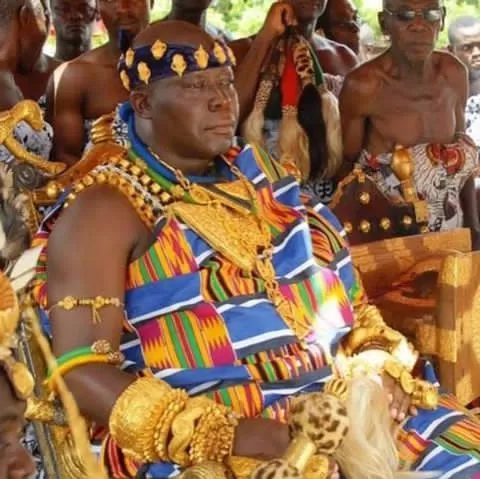
The Manhyia Palace is the seat of the Asantehene, as well as his official residence. It is located at Kumasi, the capital of the Ashanti Kingdom and Ashanti Region. The first palace is now a museum. Otumfuo Opoku Ware II built the new palace, which is close to the old one and is used by the current Asantehene, Otumfuo Osei Tutu II.
- Kumasi City Mall
The Kumasi City Mall is a state-of-the-art retail and shopping center in Kumasi, Ghana, located on the Asokwa Interchange off Kumasi Adum/Labor road. The mall, commissioned on April 20, 2017, is one of the most modern western style shopping Centres in West Africa and the first large-scale mall in Kumasi.
The mall is an opened shopping Centre. It has a retail space of 18,534 square metres with parking for over 660 cars. The Kumasi City is anchored by South African giants, Game and Shoprite and accommodates over 70-line shops, a radio station, a 5-hall cinema and 7 restaurants of which 85% are operated by Ghanaian retailers. https://www.kumasicitymall.com/
- Okomfo Anokye Sword Site
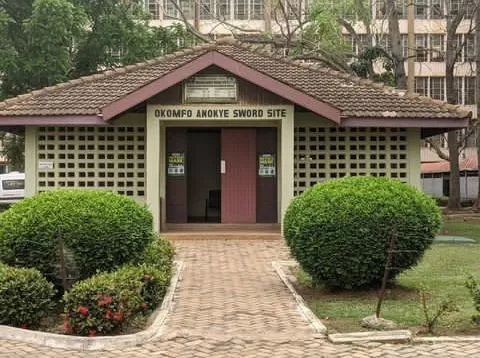
The ‘immovable’ Sword driven into the ground by Okomfo Anokye remains and is venue of the Okomfo Anokye Teaching Hospital.
History has it that the sword was pushed into the ground, almost 300 years ago. It is believed the Okomfo pronounced that no one would be able to remove the sword, and so it has remained in spite of attempts. The Ashanti state, it is believed, would collapse should the sword ever be pulled out of the ground.
- Kejetia Market
The Kumasi Central Market (also known as Kejetia Market) is an open-air market in the city of Kumasi. The Kejetia market is the largest single market in West Africa. It has over 10,000 stores and stalls.
The ultra-modern million dollar market is the largest in West Africa where visitors can shop for products ranging from food, clothes, shoes, slippers, perfumes and so on.
The market has retail outlets for products, bus terminals, fire station, police station, a clinic to take of patients and so on.
- Kumasi Fort – Ghana Armed Forces Museum
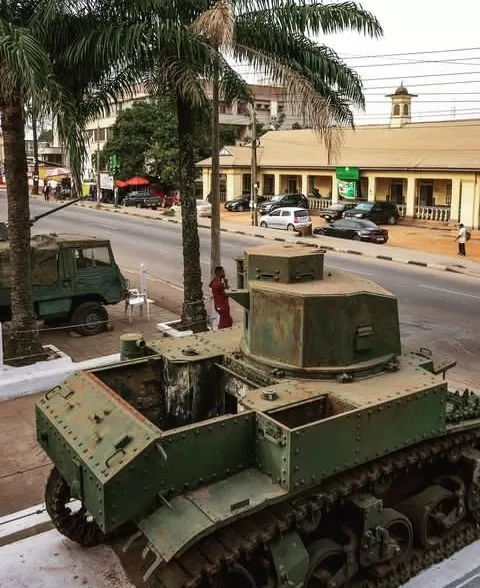
The Kumasi Fort and Military Museum is one of few military museums in Africa. It is located in the Uaddara Barracks in Kumasi, the capital city of the Ashanti Region of Ghana. The Prempeh Museum, Kumasi Cultural Centre, Kumasi Zoo and Kumasi Central market are all within walking distance of the fort.
The Kumasi Fort was built in 1820 by the Asantehene (the King of the Asante Kingdom), Osei Tutu Kwamina, to resemble the coastal forts which were built by European merchants. Kumasi Fort had to be rebuilt in 1897, after it was destroyed by British forces in 1874. The fort was built from granite and brown soil that was brought from Cape Coast to Kumasi by porters.
In March 1900, during the Asante Rebellion, the fort was encircled, and 29 Britons were trapped inside for several weeks. The leader of this rebellion was the Queen Mother of Ejisu, Ohemaa Yaa Asantewaa. After a brief period of imprisonment in the fort, she was forced into exile in the Seychelles, where she died. From 1952 to 1953, after the Second World War, the Armed Forces of the British Colonial Government took over the fort and converted it into a museum.
Exhibits include: military equipment, artefacts and other objects used in the British-Asante war of 1990 and during the Second World War.
The collection includes weapons of war, colours, medals, armoured cars, anti-aircraft guns, photographs and portraits. This serves as a valuable historical institution for tracing the evolution and development of the Gold Coast Regiment of the colonial era, to the present-day Ghana Armed Forces. There is a British Military Cemetery just about 200m northwest of the Kumasi Fort and Military Museum, which contains graves of British casualties of the Yaa Asantewaa War.
- Rattray Park
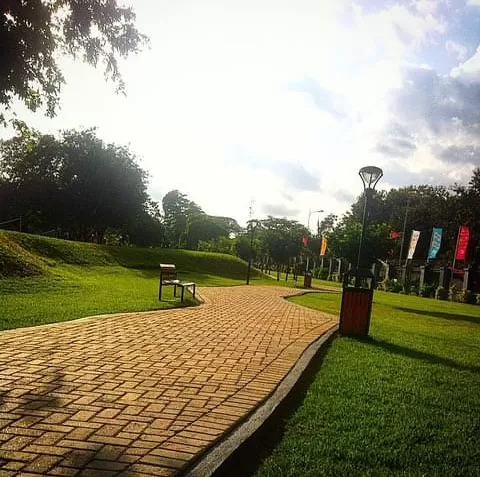
Rattray Park is just adjacent to the Golden Tulip hotel. The Rattray Park is well noted for its festive activities like the Christmas and Easter gatherings for both children and adults. The place is always open for one’s afternoon or evening relaxation, amidst and cools and good dishes.
Children like the place because it has all it takes to make them happy. Games for children are readily available here and the environment is also surrounded by trees and shrubs, making it easy for one to feel the cleanest and dust-free air.
Generally, the place is quiet and very accommodating in the afternoon.
- Millionaires Casino
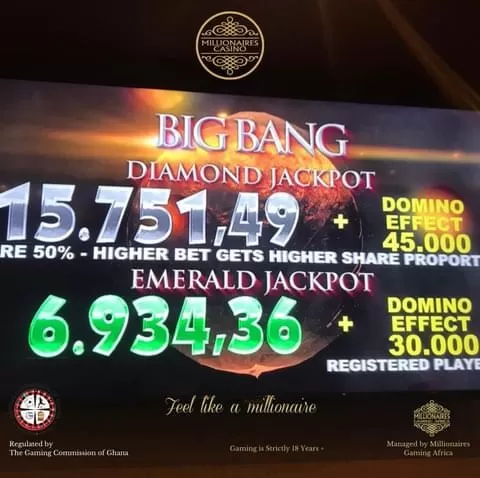
Millionaires Casino Kumasi is situated inside the Golden Tulip Hotel, which is set on the extensive tropical gardens and is on the border of the Kumasi Royal Golf Course.
Millionaires Casino offers twenty six (26) state-of-the-art slot machines including seven (7) Touch Bet Roulette terminals and 8 (eight) gaming tables. Our table games include American Roulette, Blackjack and various Poker games. Kumasi being the smallest casino in the portfolio has a total of 98% local staff is employed.
With a yearly visitor count of over 23,800 guests we pride ourselves as the ultimate gaming destination in the Ashanti Region of Ghana providing entertainment to many local and diverse international guests.
- Prempeh II Museum
Located in the centre of the National Culture grounds, the museum houses a fascinating collection of Ashanti History such as memorabilia of Okomfo Anokye, including the 300 year old antique treasure bag which he forbade anyone to open.
Also on display in this museum of Ashanti Royalty, are artifacts relating to the Ashanti King Prempeh II, including the king’s war attire, ceremonial clothing, jewelry, protective amulets, etc.
- Wesley Methodist Cathedral
Wesley Methodist Cathedral is a Methodist cathedral located in Kumasi, Ghana. Wesley is the largest Methodist church in the area and is the center of the episcopal area in Adum, Kumasi. The cathedral is named after John Wesley, one of the founders of the Methodist church.
Wesley Methodist Cathedral is an attraction worth taking a picture off and just seeing when in Kumasi. It is one of the oldest churches in Kumasi with a very picturesque building. This is a working church with regular services taking place. If you are going inside to worship take a look the brilliant dark mahogany balconies seats which add to the character of the place.
- Kumasi Zoo
The Kumasi Zoo occupies a prime site in the centre of Kumasi, providing one of the few green urban areas in Kumasi for both local citizens and visitors. It is situated in Kejetia, a suburb of the central business area of the Kumasi Metropolitan Area and is located between 6° 34’ N – 6° 46’ N and 1°30’ W – 1°44’ W of Ghana.
Kumasi Zoological Gardens (Kumasi Zoo) was opened as a result of a decision taken in July 1951 by the Asanteman Council to preserve Ashanti culture, foster social research and publish journal notes on Ashanti customs and other matters of general interest.
The Zoo was officially opened in 1957 with the purpose of displaying indigenous wild animals of Ghana in captivity (including free roaming Pea-fowls) with the view to demonstrating the linkage between wildlife and culture and thereby emphasizing the need for wildlife conservation.
The Zoo was managed at different times by the then Kumasi Municipal Council and the Forestry Department and since 1974 managed by the Wildlife Division of the Forestry Commission (formerly Department of Game and Wildlife).
Protect, manage and develop wildlife resources in the national interest and regulate the harvesting of wildlife resources. Vet the export of wildlife product, conduct pre-shipment inspection, examination of wildlife products. Develop and promote the economic potential of wildlife through eco-tourism and sustainable exploitation of wild plants and animals, including their by-products.
Develop the wildlife management capacity at the national, district and community levels including stakeholder participation of the effective management of wildlife within and outside the protected areas. Promote public awareness, understanding and support for wildlife conservation, facilitate continuous improvement in wildlife management through research.
- The Green Ranch
The Green Ranch is a family-operated eco-friendly horse-back riding off-the-beaten-track destination overlooking beautiful Lake Bosomtwe. They provide an experience like none other in Ghana or even West Africa for that matter, specializing in providing horseback riding expeditions in the lush area around this unique metorite crater lake. In addition on the ranch they run a lovely home with 3 comfortable rooms, 1 well-ventilated dormitory and 1 rustic cabin to rent.
Horse and animal lovers, Nature lovers are welcome to the ranch to come and ride on horses, stay with and experience a great vegetarian food from tasty veggie table.
Their equestrian experiences are our primary mission and they operate them with the utmost professionalism. They have 8 horses that live like Kings and Queens in a semi free way and all are ready for riding from novice to advanced levels of riders. They offer rides from one hour minimum up to the 10-hour Big Loop trip around the whole lake. Elodie, the instructor is certified in equestrian expeditions so you can rest assured your trip will go very smoothly.
- Adanwomase Kente weaving
Adanwomase is a town in the Ashanti Region of Ghana, approximately 27 km for Kumasi, the capital of the region and the second largest city in Ghana. The name means “under the Adanwo tree”.
The town is famous because of its long tradition of kente weaving. It is one of the several towns that the Asantehene (king of the Ashantis) sent apprentices from to present day Cote d’Ivoire in the late 17th century to learn about the art of weaving. danwomase is the home of the Mfufutumahene (chief responsible for weaving the traditional black and white kente for Ashanti royals) who is the custodian of the seseɛ (small basket containing all historical samples of kente woven in Adanwomase).
Kente weaving and its associated commercial activities continues to make a substantial contribution to the town and other kente weaving communities in Ashanti. More recently the town has focused non ecotourism as an important industry, together with the opening of the Visitor Centre.
People from all over the world including the African diaspora come to visit the town where they are given guided tours during which they learn about the history and cultural significance of kente and as well as demonstrations of the weaving technique for the fabric.
In 2018 the authorities in Adanwomase established a festival to promote the cloth and the town as a tourist destination. In September 2019 our team attended the festival. Activities included a display of colourful kente cloth, cultural drumming and dancing and a durbar attended by the chiefs and elders of the town as well as dignitaries from outside the town. The festival site was awash with brightly colored kente worn by those who attended. We hope that you enjoy these pictures and clips from our visit which should give the reader an indication of what happens there on the day.
- Ahwiaa wood carvings
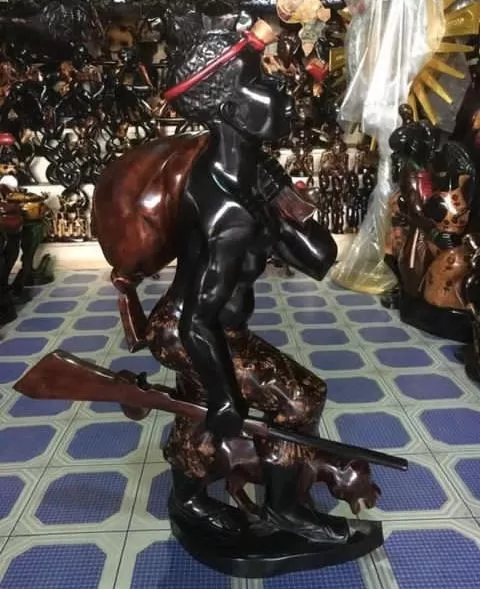
Ahwiaa is a town in the Kwabre East District of the Ashanti Region noted for its wood carvings, arts and crafts.
Ahwiaa is where the famous Ashanti stools and Akuaba fertility dolls are produced. At the carving sheds, one can observe craftsmen creating impressive carvings from solid barks of wood. These skilful carvers also produce masks, symbolic figures, bone and ivory beads and walking sticks.
- Bobiri Butterfly sanctuary
Bobiri is just off the main Accra-Kumasi Road and directional for the turnoff at Kubease. Take the dirty road from the village 3.5 km to the visitor centre. By trotro from Accra, ask to be dropped off at Kubease and then hire a taxi or walk 3.5 km to the guesthouse. From Kumasi, take a trotro to Ejisu, then hire a taxi or take a second trotro to Kubease.
The Bobiri Forest and Butterfly Sanctuary is 54 square kilometres of virgin semi-deciduous tropical rainforest offering natural delights and one of the nicest ecotourism visitor centres and guesthouses in Ghana. See Bobiri’s massive trees, wide variety of birds, landscape butterfly garden (to showcase the sanctuary’s 400-plus butterfly species) and arboretum with plant labels. Each room of the guesthouse and visitor centre features a different mural painting created by a talented local artist.
The forest is enjoyable anytime, but butterflies are most abundant March through June, with May being the peak most visible and active between 11 am – 4 pm on warm, sunny days. Sturdy shoes are recommended for hiking, as well as rain gear during the rainy season. Enjoy the visitor centre’s comfortable chairs and shaded porch as you plan your hike and meet your guide. The centre also offers Ghanaian board games for relaxation and local drums to try.
Take a guided nature walk which includes the sanctuary’s oldest tree (300-plus years) and its largest (it takes 24 people joining outstretched arms to encompass the tree).
- Ntonso Adinkra Arts and crafts village
Ntonso is the homeland of adinkra cloth and the only place in Ghana where traditional adinkra is made locally from scratch. Ntonso is still Ghana’s biggest producer of adinkra, a cloth famed for its symbols and proverbial wisdom. The cloth was originally worn only for funerals in the Ashanti Region and produced mainly in black, brown and red. These days, however, it is made in all colors and used throughout Ghana.
Ntonso has a new visitor center and lays on official guided tours. On a walking tour, visitors can engage in the various stages of adinkra production, such as dye preparation, cloth dyeing, adinkra stamping and embroidery of stamped cloth.
- Bonwire Kente Weaving
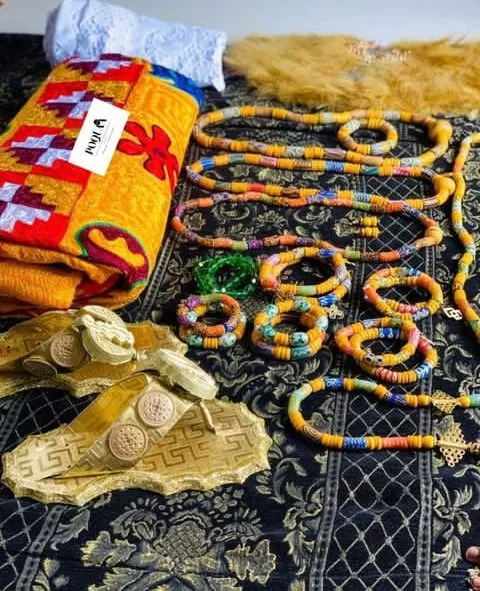
According to legend, two friends from the town of Bonwire – now the leading centre of kente weaving in Ashanti – learned the art of weaving by observing a spider spinning its web. The fabric later became a royal cloth and symbol of prestige. As production increased, the cloth became more affordable; but its special status has remained. Kente is worn for its symbolic significance not only for its eye- catching designs. There are over 300 patterns, each with its own name and meaning derived from proverbs, historical events, important chiefs and valuable plants.
Legend has it that in the middle part of the 17th century AD, at Bonwire in Asante, two brothers from Asona clan of Bonwire, Kuragu and Ameyaw who were hunters by profession and hardly 20 years old, studied the way and manner, the slider (Ananse) wove its web in a forest at Bonwire-Kurankye (Ayewakeseho). After series of experiments, they came up with a type of fabric known in Asante-Twi language as “Nwin-Ntom”, woven-cloth in the English language. They reported their invention to the chief of Bonwire (Bonwirehene), Nana Bobie Ansah I (1610-1727) who in turn accompanied them to Kumasi, the capital of the Asante Kingdom to show their discovery to the king of Asante (Asantehene) Otumfuo Opemso Osei Tutu I (1695-1717).
The Asantehene was so fascinated by the invention that he adopted it as a royal art. the first cloth made was called”Gagamuga”. A few years later, Kuraga and Ameyaw came up with an improved form of their discovery. The improved form had the looks of the surface of a basket (Kenten). The people of Bonwire called the new fabric, (Kenten-Nwin-Ntoma), a woven-basket-cloth. The phrase was shortened to “Kenten-Ntoma” – Basket Cloth. The word, ” Kenten”, was later corrupted to KENTE.
Once again, the inventors reported the improved form of their invention to the chief of Bonwire (Bonwirehene). The Bonwirehene took them to the new king of Asante (Asantehene) Otumfuo Okatakyie Opoku Ware I (1720-1750). In 1721, the Asantehene created a Kente-Stool (Kentehene) for Nana Kuraga and Nana Ameyaw as a mark of their invention. In the same years, he created the Oyokomaa Stool (Yokomaahene) for Nana Otaa Kraban from the Oyoko clan of Bonwire for introducing primary colours (red, yellow, green and black) into Kente-Weaving. Before the introduction of primary colours into kente-weaving, kente was woven in white, black and indigo only ( Fufutoma), fufutoma is a cloth which colours are white dominated.
In the middle of 19th century AD, one Nana Osei Kuffour, from the Agona clan of Bonwire, introduced geometrical designs (adwini) into kente-weaving, so, he was crowned a master-weaver. In the year 1990, a stool called “Awinfohene” was created for his descendants at the court of the king of Asante (Asantehene) by Asantehene Otumfuo Opoku Ware II (1972-1999). It was in the same year (1990) that a man from Adangomase, a town near Bonwire, was rewarded with a stool called “Fufutumahene”. The people of Adangomase, learnt the art of Kente weaving from Bonwire through schooling at Bonwire and inter-marriages between the people of Bonwire and Adangomase in the middle of 20thcentury.
All stools created by the Kings of Asante in connection with Kente were placed under the Gyaase division of the Asante King’s court. Here, custom and tradition demand that Asantehene’s kente is made at Bonwire through his Kente chiefs (Kentehene, Yokomaahene and Awinfohene) and of late, fufutoma, through Fufutomahene, at the head of Asantehene’s Abenasehene of the Gyaase division of Kumasi.
Kente, weaving has gone through many stages of development. Nana Kuragu and Nana Ameyaw developed their first weaving system called “Ayaase-Nwin-Ntoma” or “Ayaasentoma” that is, Cloth woven at the solar plexus, using raffia fiber “edowa” for yarns.
Still with raffia fiber “edowa”, Nana Kuragu and Nana Ameyaw developed a second weaving system called “Asaase-Nwin-Ntoma” or “Asaasetoma” that is, cloth woven on the ground. The third weaving system they developed was an improved form of the “Asaasetoma” in which they used yarns from silk-cotton-tree “onyina”.
The third weaving system was in two types, type A and type B. Cotton from silk-cotton-tree is called “ Onyina-Atenenhuo” in Akan-Asante language (Twi). The fourth weaving system they developed was called “Nsaduaso-Nwin-Ntoma” or “Nsaduatoma” cloth woven at the loom. It is on the loom that the first cloth called “Gagamuga” that is, pinstripe, was made. The word “Gagamuga” is re-duplication of the word “aga” which is referred to the lowest denomination of the Akan-Asante currency in the olden days.
Otaa Kraban, it is said, improved upon the Kuragu-Ameyaw hand-loom, after he (Otaa Kraban) had returned from a trip to the Gyaman city of Bondugu (Bontuku) in today La Cote D’voire. It must be noted that his trip to Bondugu (Bontuku) was after the invention of kente at Bonwire.
In the middle of the 20thcentury, Nana Tiko, Nana Kwaku Menso and Nana Kwame Duodu, all of Bonwire, took the kente industry to another level by introducing newbrands of kente called Asasia, Antokoo (Kontompotoma) and Kyerewere (Kyekyere Wowere).
- Lake Bosumtwi
Lake Bosumtwi is the only natural lake in Ghana. It is situated within an ancient impact crater that is about 10.5 kilometres in diameter. It is about 30 km south-east of Kumasi, the capital of Ashanti, and is a popular recreational area.
- Pankrono pottery
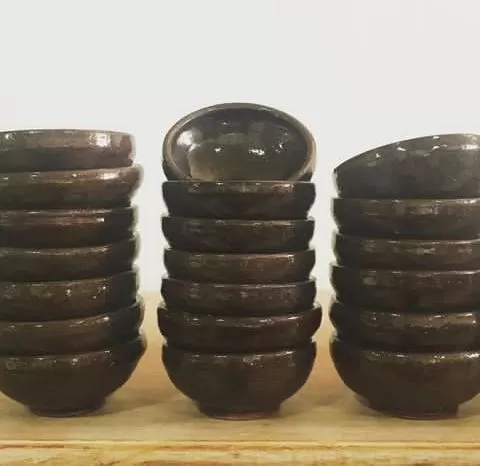
Another attractive site in Kumasi is the Pankrono pottery. Pankrono is located 8km on Mampong Road in the Ashanti Region. It is famous for its outstanding pottery, created without the use of the potter’s wheel. Pottery making is one of the interesting traditional activities in the area within the Ashanti region.
Thank you for reading this article.
Related articles
How to enjoy vacation in Accra Ghana
